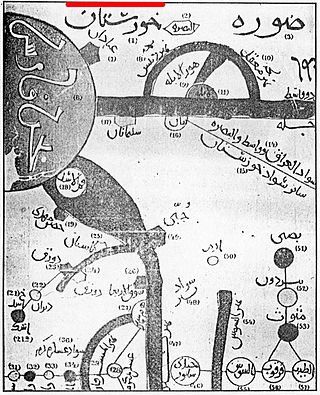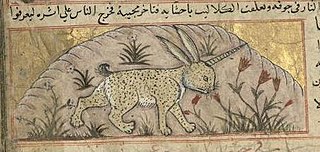
The simurgh is a benevolent bird in Persian mythology and literature. It bears some similarities with mythological birds from different origins, such as the phoenix and the humā. The figure can be found in all periods of Iranian art and literature and is also evident in the iconography of Georgia, medieval Armenia, the Eastern Roman Empire, and other regions that were within the realm of Persian cultural influence.

Although Herodotus and Xenophon referred to the entire region as Susiana, the name Khuzestan is what has been referred to the southwesternmost province of Persia (Iran) from antiquity.

Abū al-ʻAbbās Ahmad ibn Muhammad at-Tijāniyy or Ahmed Tijani, was an Algerian Sharif who founded the Tijaniyyah tariqa.

Ramadan is the ninth month of the Islamic calendar, and the month in which the Quran is believed to be revealed to the Islamic prophet Muhammad.

Old Azeri is the extinct Iranian language that was once spoken in the northwestern Iranian historic region of Azerbaijan before the Turkification of the region. Some linguists believe the southern Tati varieties of Iranian Azerbaijan around Takestan such as the Harzandi and Karingani dialects to be remnants of Old Azeri. Along with Tat dialects, Old Azeri is known to have strong affinities with Talysh and Zaza language and Zaza and Talysh are considered to be remnants of old Azeri. Iranologist linguist W. B Henning demonstrated that Harzandi has many common linguistic features with both Talysh and Zaza and positioned Harzandi between the Talysh and Zaza.

Al-Mi'raj or Almiraj is a mythical creature resembling a one-horned hare or rabbit, mentioned in medieval Arabic literature.
The verse (ayah) 256 of Al-Baqara is a very famous verse in the Islamic scripture, the Quran. The verse includes the phrase that "there is no compulsion in religion". Immediately after making this statement, the Quran offers a rationale for it: Since the revelation has, through explanation, clarification, and repetition, clearly distinguished the path of guidance from the path of misguidance, it is now up to people to choose the one or the other path. This verse comes right after the Throne Verse.
Zaid Abdullah Al-Harb (1887 – February 21, 1972) was a Kuwaiti poet.

Aja'ib al-Makhluqat wa Ghara'ib al-Mawjudat or The Wonders of Creatures and the Marvels of Creation is an important work of paradoxography and cosmography by Zakariya al-Qazwini, who was born in Qazwin in 1203 shortly before the Mongol invasion of the Khwarazmian Empire.

Mount Qaf, or Qaf-Kuh, also spelled Cafcuh and Kafkuh, or Jabal Qaf, also spelled Djebel Qaf ; Koh-i-Qaf, also spelled Koh-Qaf and Kuh-i-Qaf or Kuh-e Qaf ; or Kaf Dağı in Turkish is a legendary mountain in the popular mythology of the Middle East. In some early Arab traditions, Mount Qaf is said to be the homeland of the jinn and was made out of shining emerald by God.
Al Dair is a village in Bahrain on the northern coast of Muharraq Island. It lies north of the Bahrain International Airport, and north west of Samaheej village.
Nelly Artin Kalfayan, better known by only her mononym Nelly, is an Egyptian actress, singer, comedian, dancer, television personality, and all-around entertainer.

Youssef Hourany was a Lebanese writer, archeologist and historian. Hourany received his diploma in philosophy, from the Lebanese University, and his PhD on the ancient philosophy of history from The Université Saint-Esprit de Kaslik.
Khatim al-Awliya' is a work by Al-Hakim_al-Tirmidhi. It was authored around 873. Ibn Arabi later expanded on the notion.
The Zabaniyah is the name of a group of angels in Islam who are tasked to torture the sinners in hell. They are mentioned appeared in many verses in Quran, With various names such as "Nineteen angels of Hell", "Angels of punishment", "Guardians of Hell", "Wardens of hell", and "Angels of hell" or "The keepers".
Dua Al-Ahd is an Arabic language allegiance supplication prayer for Hujjat-Allah al-Mahdi, twelfth Imam of Shia Islam. This is also known as Ahad Nama in Asian Country like India, Pakistan.
Sheikh Abdul Bāqi Miftāh is a Sunni Islamic scholar of Sufism from Guemar, Algeria. He is known for his writings on Ibn al-Arabi.
Abd al-Rahman Abd al-Khaliq was an Egyptian-Kuwaiti Islamic scholar and preacher. He published more than 60 books related to Islam, especially Salafism.

Al-Khalidiah is a low-income residential neighborhood in southeastern Riyadh, Saudi Arabia, located south of as-Sinaiyah and west of al-Faisaliyyah in the sub-municipality of al-Batʼha. It emerged as an offshoot of Hillatal-Anouz and was renamed in the 1980s after King Khalid bin Abdulaziz. It is today inhabited mostly by overseas Indian, Pakistani, Bangladeshi and Yemeni migrant workers and their families.

Muhammad al-'Arabi al-Tabbani, also known as Abu Hamid ibn Marzuq was an Algerian Maliki jurist (faqih), Ash'ari theologian, Hadith scholar (muhaddith), historian (mu'arrikh), and a genealogist (nassāba), who was the Imam of the Great Mosque in Mecca in his time.











